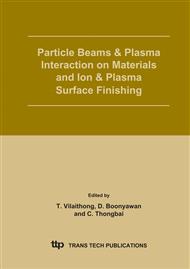[1]
Research paper of development strategy of national natural science, 1991, Nuclear technologies P162, Science Press.
Google Scholar
[2]
Yuejin Wu et al. The mechanism study of nitrogen ion poured into rice , the journal of Anhui agricultural university 1994,21(3):241·245.
Google Scholar
[3]
Hu Nengshu, Wan Xianguo, Pang Boliang et al. Investigation on increasing mutagenic efficacy for breeding and genic effect of irradiation, ⅡA study on genic effect of irradiation in crops. Laser Biology 1995, 4(2): 664·672.
Google Scholar
[4]
Guoping Lin, et al. Study of the effect of ion implantation on tobacco seed. The Journal of Anhui Agricultural University, 1991, 18(4): 317.
Google Scholar
[5]
Dongguan Zhen, et al. The mutation application of ion implantation on cotton breeding , the Journal of Anhui Agricultural University, 1994,21(3):315·317.
Google Scholar
[6]
Zhenxiang Wu, et al. The application of ion implantation on tomato breeding, the Journal of Anhui Agricultural University, 1994 21(3) 321·325.
Google Scholar
[7]
Detian Cai, et al. The study of high frequency apomixes rice, the Journal of Agricultural University of Central China, 1991 (10)3:223·227.
Google Scholar
[8]
Lanpei Wu, Hairui Cui, et al. The mechanism of Nitrogen ion beam mutation (second), the Journal of Anhui Agricultural University, 1994 21(3):233·240.
Google Scholar
[9]
Hairui Cui. The bioeffects and cell heredity study of wheat and rye via ion implantation, Thesis for the Doctorate, (1995).
Google Scholar
[10]
Li Sheng, et al. The preliminary application research on silkworm mutation via low energy ion, the Journal of Anhui Agricultural University, 1994 21(3):326·329.
Google Scholar
[11]
Lu Wei et al. The application of ion implantation on rifamycin production bacterium inducement effect,The second national ion implantation bioeffect science dissertation collection, (1993).
Google Scholar
[12]
Xianxian Zeng. Studies of Biolagical effect and Crop Modification by Ion Implantation, Journal of Xinjiang Institute of Technology 1996 17 (1): 56·59.
Google Scholar
[13]
Zengliang Yu. The progress of ion implantation bioeffect and breeding. the Journal of Anhui Agricultural University, 1991, (4) ,251·257.
Google Scholar
[14]
Jiping Tong, Yuejin wu, et al. The discovery and preliminary research on the dominant semidwarf rice plasm. Chinese Rice Science, 2001. 15(4):314·316.
Google Scholar
[15]
Jiping Tong, Yuejin wu, et al. The heredity research on the dominant semi-dwarf indica mutant Y98149. Crop journal. 2003. (3):519·524.
Google Scholar
[16]
Jiping Tong, Yuejin Wu, et al. A Dominant Semi-dwarf Mutant in Rice. Chinese Rice Research Newsletter. 2002. 10(1): 7·8.
Google Scholar
[17]
Zhiguo Zhang, Yuejin Wu, et al. The preliminary RAPD research on Dominant Semi-dwarf Mutant gene in Rice, the Journal of Anhui Agricultural University, 2003, 3: 5·8.
Google Scholar
[18]
Qiucheng Yu, Baocai Huang, et al. The status and view of crop space mutation breeding. the Journal of Jiangsu Agricultural sciences, 2001, 4: 3·7.
Google Scholar
[19]
Zengliang Yu. Introduction to ion beam Biotechnology 1998 Science & technology of Anhui Province Press.
Google Scholar
[20]
Yu Zhengliang, Yang Jianbo, Wu Yuejin et al, Transferring Gus gene into intact rice cells by low energy ion beam. Nuclear Instruments and Methods in Physics Research. 1993, B80/81: 1328~1331.
DOI: 10.1016/0168-583x(93)90793-6
Google Scholar


